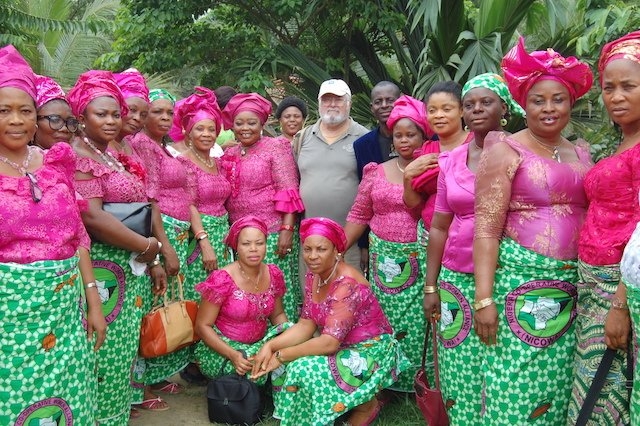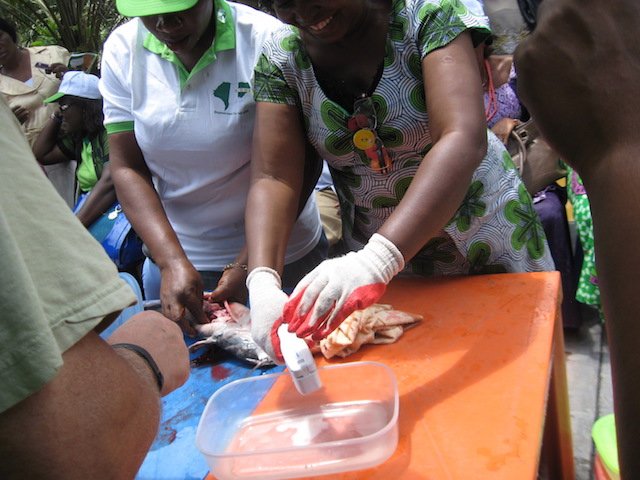
News & Views
Grassroots approach provides catfish fingerlings for sub-Saharan farmers
Through a grassroots approach, a USAID-funded program is offering a solution for sub-Saharan Africa’s fish farmers’ perennial problem of sourcing catfish fingerlings.
February 1, 2018 By Ruby Gonzalez
 Volunteer trainer Dr. Joseph Sullivan with some of the chapter leaders of the Nigerian Co-operative Women’s Alliance who participated in the workshop. Photo credit: Dr. Joseph Sullivan
Volunteer trainer Dr. Joseph Sullivan with some of the chapter leaders of the Nigerian Co-operative Women’s Alliance who participated in the workshop. Photo credit: Dr. Joseph Sullivan The John Ogonowski and Doug Bereuter Farmer-to-Farmer program provides “training in spawning techniques and rearing fry to pond-hardy fingerling sizes.”
The training on sharp tooth catfish fingerling production is one of the more common requests by private farmers in the region.
The power of one
“The sharp tooth catfish industry can be divided into fingerling producers and grow-out farmers,” notes Dr Joseph Sullivan, a fisheries and aquaculture expert, in an abstract of a presentation he made at World Aquaculture 2017 in South Africa last June.
“Catfish cannot reliably be expected to spawn in ponds and those that do face high losses of juveniles for various reasons. Even in areas where catfish fingerling producers exist, they often want to sell only to larger buyers, leaving the home backyard fish farmer at a loss for a supply of fingerlings,”
“Cooperatives can remedy this situation, but require training in spawning techniques and rearing fry to pond-hardy fingerling sizes,” he added. One knowledgeable and capable co-op member can supply other members with these fingerlings,”
A volunteer at Winrock International since 2011, Sullivan told Hatchery International that each workshop is composed of lectures and hands-on training. Winrock is among the NGOS that have executed the catfish fingerling production projects.
Workshop on a stick
At the end of the workshop Sullivan gives the host a memory stick containing presentations and other reference materials made in preparation for the workshop. He also gives out his business card so they know where to reach him for questions or advice.
 |
| Workshop participants are shown how to squeeze catfish testes through a garlic press. Photo credit: Dr Joseph Sullivan |
Subjects covered include broodstock selection, inbreeding avoidance, various natural and artificial spawning methods, incubation requirements, best methods to get larvae onto artificial feed, and locally available ingredients for feed.
Hands-on training includes injecting female catfish with artificial hormones or pituitaries, followed by spawning the appropriate number of hours later, fertilizing the eggs, placing them in the incubators and then examining the fry after they hatch.
Among Sullivan’s workshops, he said the most successful could be the one in Nigeria, attended by about 120 chapters of the Nigerian Cooperative Women Alliance. Each chapter was represented by one member.
It had a two-pronged goal: producing the much-needed fingerlings to generate income while continuing to take care of their families.
Sometimes, unforeseen circumstances happened even before a workshop started. One time all the catfish adults needed for the spawning/egg incubation training escaped. “We did have some sub-adults, so we practiced injecting hormones and removing pituitary glands with them, but, of course, had nothing to spawn nor eggs to incubate,” he noted.
If there was one positive offshoot of the unfortunate oversight, he added, it was that the class certainly figured out afterwards how to make a catfish escape-proof fence.
Print this page
Advertisement
- Japanese firm succeeds in full cycle octopus culture
- Finland develops real-time application for broodstock enhancement





